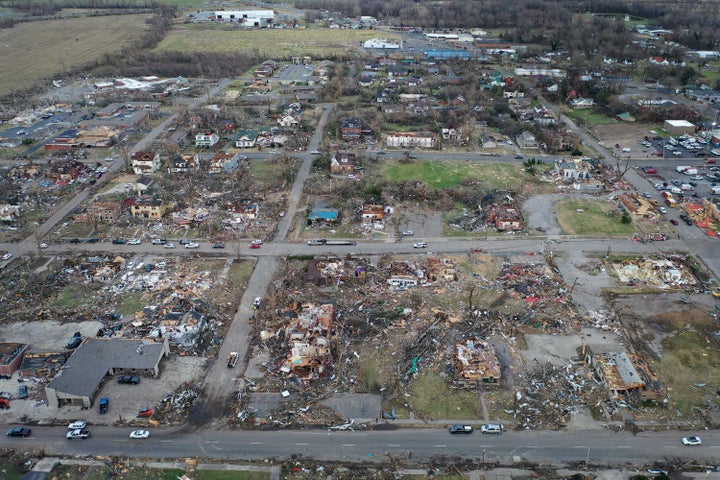The Federal Emergency Management Agency’s administrator said Sunday that the swarm of deadly tornadoes that hit the Midwest and the South this weekend will be the “new normal” in the era of a worsening climate crisis.
On CNN’s “State of the Union,” Deanne Criswell told Jake Tapper that her agency sent a federal urban search-and-rescue team to Kentucky, one of six states hit by the twisters that landed on a mid-December night with springtime temperatures. The team will help localities with ongoing rescue efforts ― as officials already count dozens dead ― while FEMA will work with states and the American Red Cross to support short-term shelter and long-term housing needs.
“You know, I think it’s incredibly unusual. We do see tornadoes in December, that part is not unusual. But at this magnitude, I don’t think we have ever seen one this late in the year,” she said. “But it’s also historic. Even the severity and the amount of time this tornado or these tornadoes spent on the ground is unprecedented.”
Tornadoes usually last only a few minutes when thunderstorm updrafts lose energy. But once Friday night’s storms formed, experts said unprecedented strong wind shear appeared to have prevented the twisters from dissipating ― resulting in a disaster that lasted hours and traveled more than 200 miles at over 50 miles per hour.
Scientists are still trying to figure out many complicated factors about whether human-caused climate change is resulting in more common and intense tornadoes, The Associated Press reported. An average of 1,200 tornadoes hit the U.S. yearly ― a number no other country has experienced ― according to the NOAA National Severe Storms Laboratory.
Less than 10% of severe thunderstorms produce tornadoes, which makes it tricky for scientists to conclude climate change’s level of influence on the twisters, tornado scientist Harold Brooks told the AP. Brooks said the U.S. will likely see more tornadoes occur in the cool season as warm weather in the winter becomes more common as the planet warms.
“This is going to be our new normal. And the effects that we’re seeing from climate change are the crisis of our generation,” Criswell said. “We’re taking a lot of efforts at FEMA to work with communities to help reduce the impacts that we’re seeing from these severe weather events and help to develop systemwide projects that can help protect communities.”
“And so we will continue to work on helping reduce the impacts,” Criswell continued, “but we’re also prepared to respond to any community that gets impacted by one of these severe events.”

Jason Furtado, a professor with the University of Oklahoma School of Meteorology, told the AP that tornado alley ― which describes the region where many twisters hit ― is moving eastward from its original Kansas-Oklahoma area, into the Mississippi River Valley and Ohio River Valley, where Friday’s tornadoes took place. He said the shift is due to the increases in temperature, moisture and wind shear.
Kentucky was the worst-hit state by far in the swarm of twisters that leveled entire communities and left a steadily increasing number of people dead. Gov. Andy Beshear told CNN on Sunday that the disaster was “the deadliest tornado event we’ve ever had,” confirming more than 80 Kentuckians dead and estimating the number will exceed 100.
“I’ve got towns that are gone, that just, I mean gone. My dad’s hometown ― half of it isn’t standing,” he said, saying the list of people unaccounted for in that town of 2,700, Dawson Springs, “was about eight pages single-spaced.”
“It is hard for me to describe. I know people can see the visuals, but that goes on for 12 blocks or more in some of these places. And it’s going to take us time. I mean, you think you go door-to-door to check on people and see if they’re OK,” he continued. “There are no doors. The question is, is somebody in the rubble of thousands upon thousands of structures? I mean, it is devastating.”

